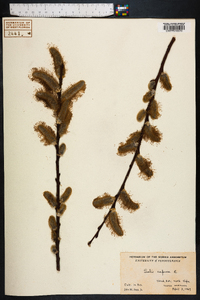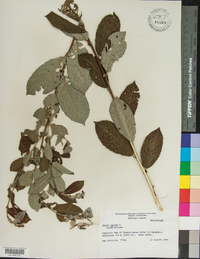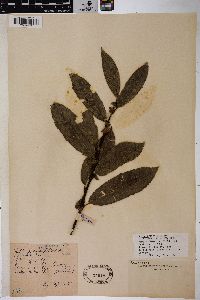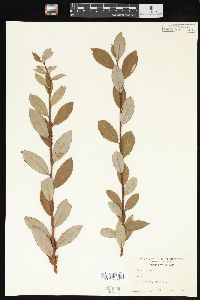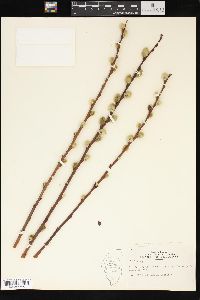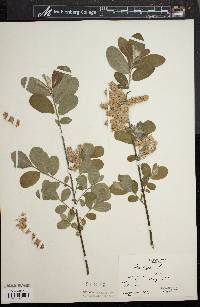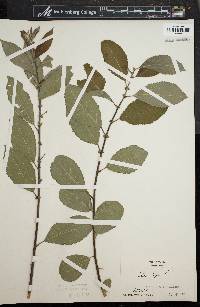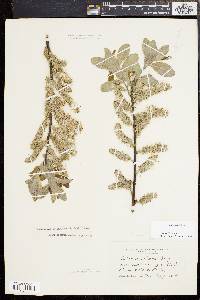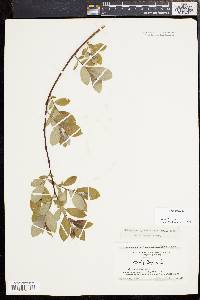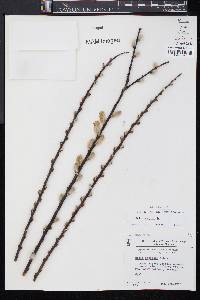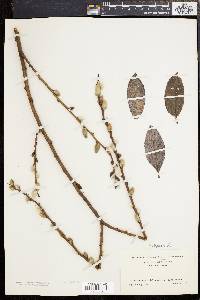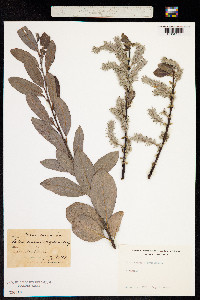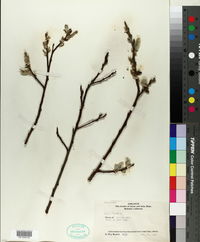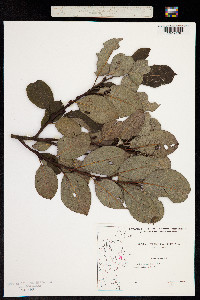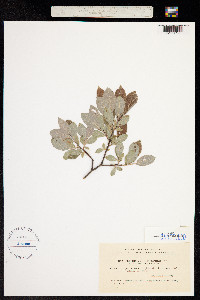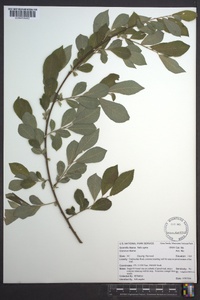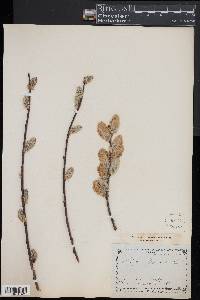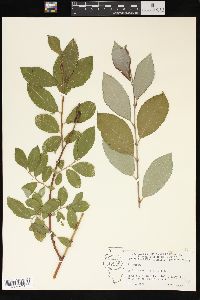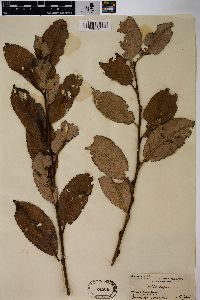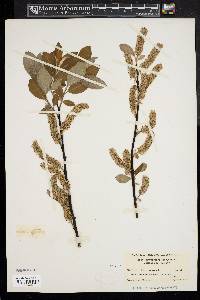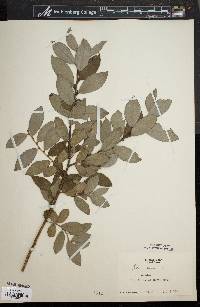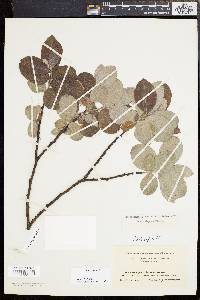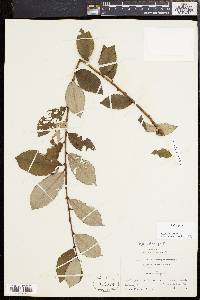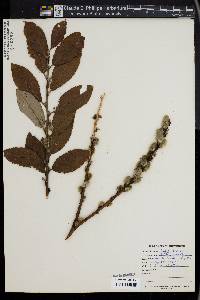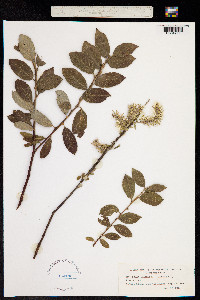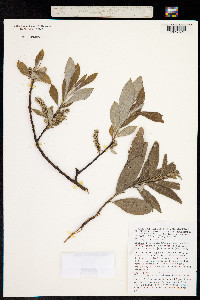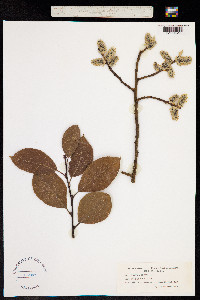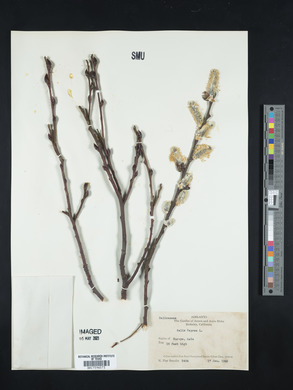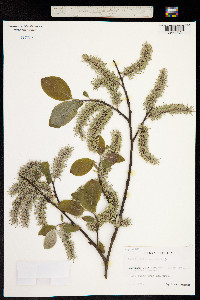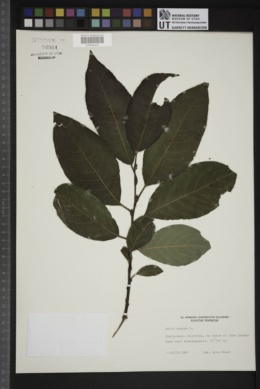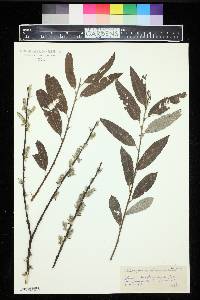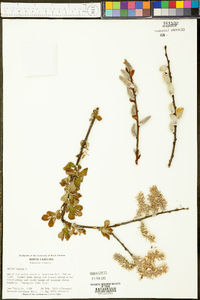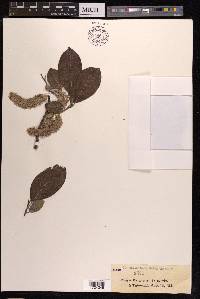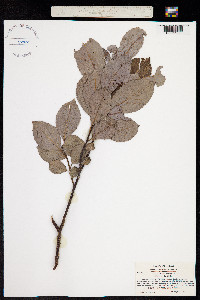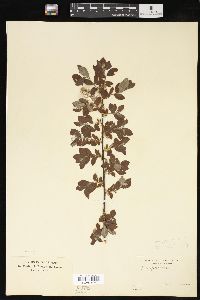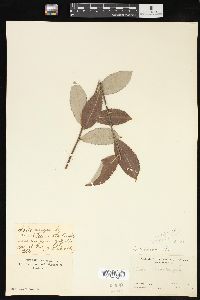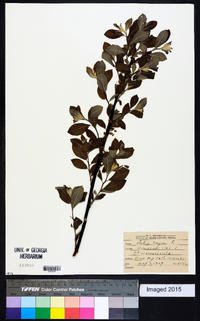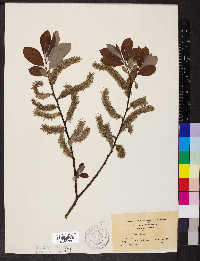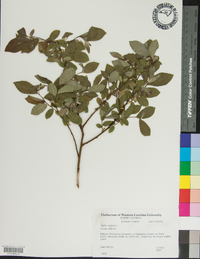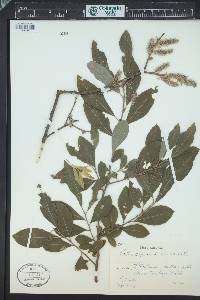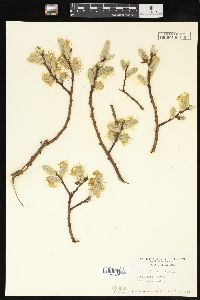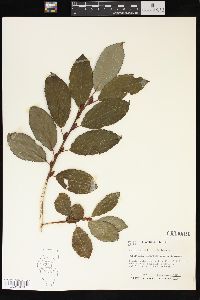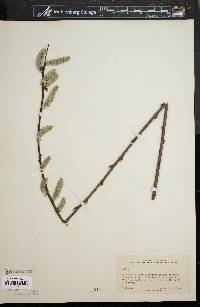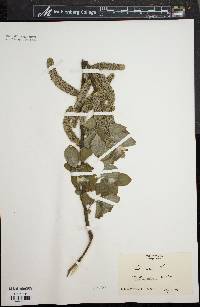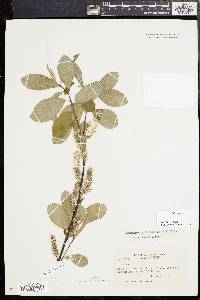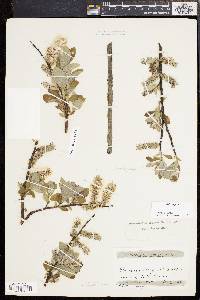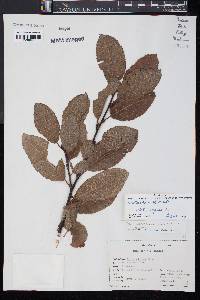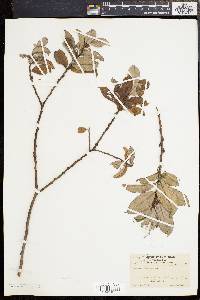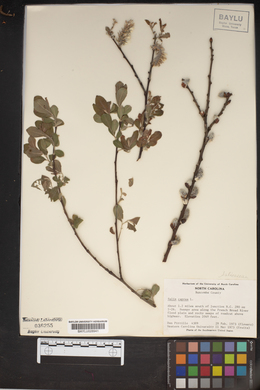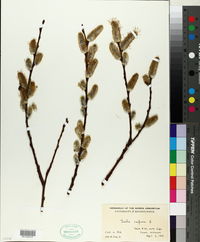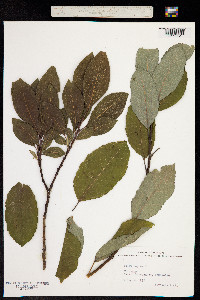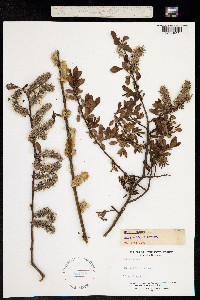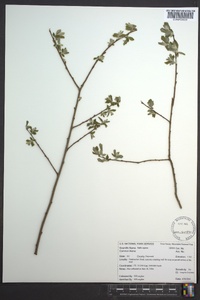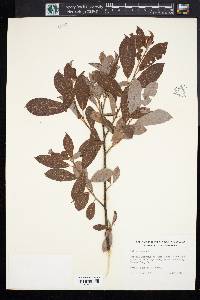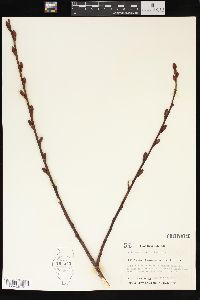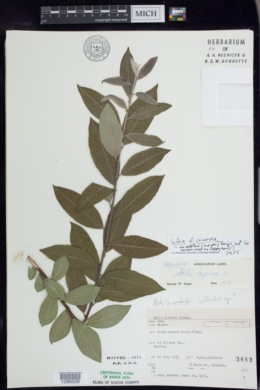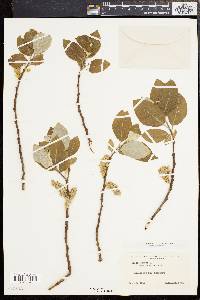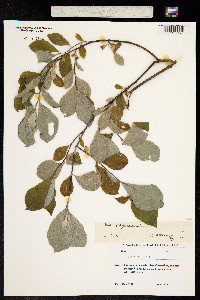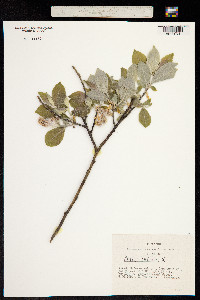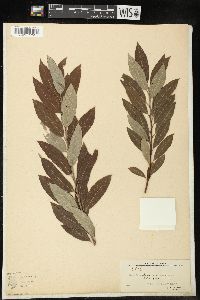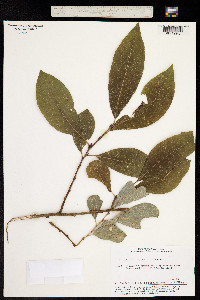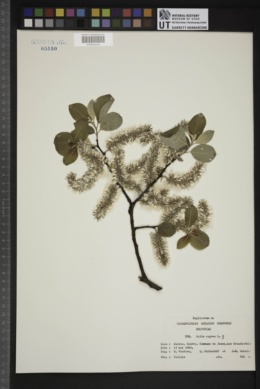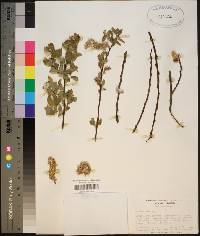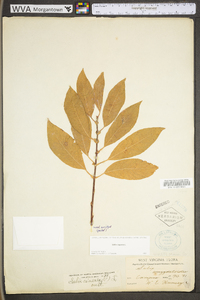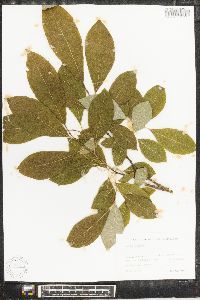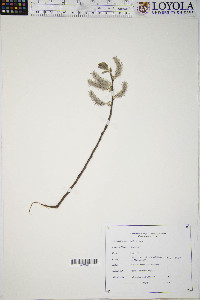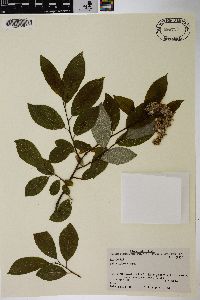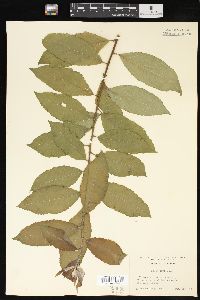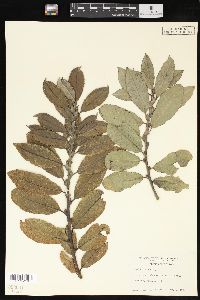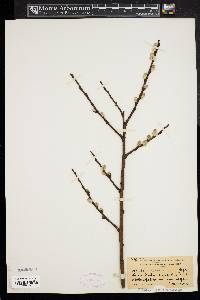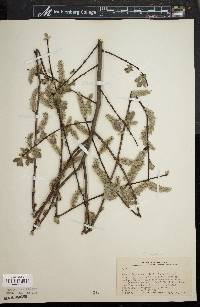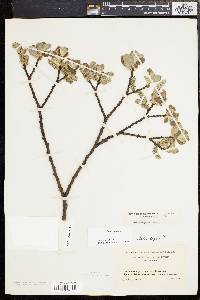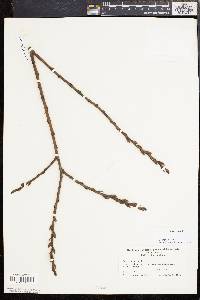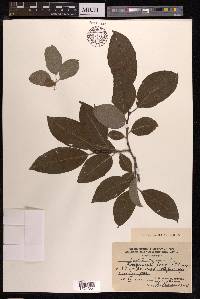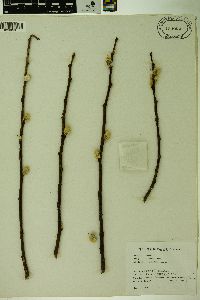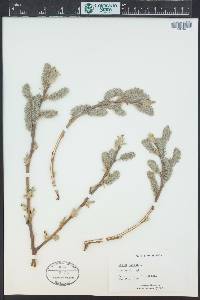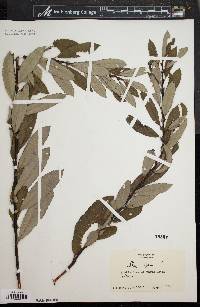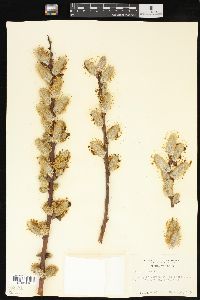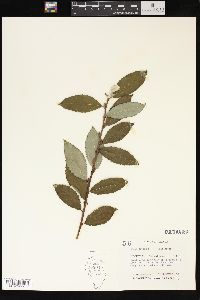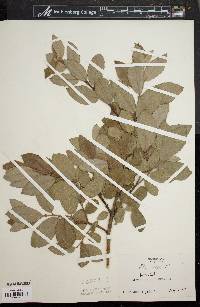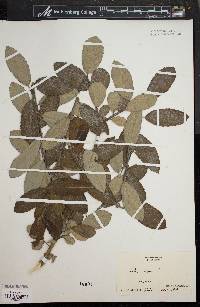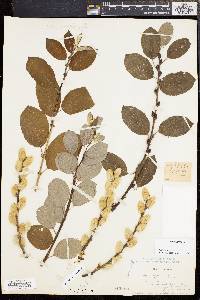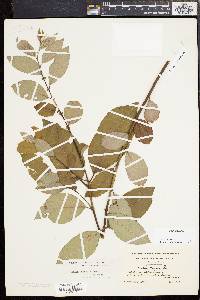Salix caprea
|
|
|
|
Family: Salicaceae
Goat Willow
[Salix bakko Kimura, moreSalix grandifolia , Salix hultenii Flod., Salix hultenii var. angustifolia Kimura] |
Shrubs or trees, 8-15 m. Stems: branches brownish, not glau-cous, pubescent to glabrescent, (peeled wood smooth or striate, striae sparse, to 6 mm); branchlets yellow-brown or gray-brown, sparsely to densely villous, velvety, or pubescent. Leaves: stipules rudi-mentary on early ones, foliaceous on late ones, apex acute or convex; petiole convex to flat adaxially, 7-25 mm, tomentose to glabrescent adaxially; largest medial blade narrowly elliptic, broadly elliptic, oblanceolate, obovate, or broadly oblong, 50-130 × 25-80 mm, 2-3 times as long as wide, base cuneate or convex, margins slightly revolute, entire, crenate, or sinuate, (glands submarginal or epilaminal), apex acuminate or convex, abaxial surface glaucous, sparsely tomentose or pubescent, hairs erect, wavy, adaxial dull or slightly glossy, sparsely pubescent; proximal blade margins entire; juvenile blade green, densely tomentose abaxially, hairs white, sometimes also ferruginous. Catkins flowering before leaves emerge; staminate subglobose or globose, 16-39 × 12-30 mm, flowering branchlet 0-3 mm; pistillate densely flowered, stout or subglobose, 27-64 × 10-25 mm, flowering branchlet 0-7 mm; floral bract dark brown or black, 2-4 mm, apex acute or rounded, abaxially hairy, hairs (white), straight. Staminate flowers: adaxial nectary oblong or square, 0.4-0.7 mm; filaments distinct, glabrous; anthers yellow, ellipsoid or shortly cylindrical, 0.7-1.1 mm. Pistillate flowers: adaxial nectary oblong, narrowly oblong, or square, 0.4-0.9 mm, shorter than stipe; stipe 2-2.5 mm; ovary pyriform, densely short-silky, beak gradually tapering to styles; ovules 12-14 per ovary; styles 0.3-0.6 mm; stigmas slenderly cylindrical, 0.4-0.55-0.6 mm. Capsules 6-12 mm. 2n = 38. Flowering mid Mar-mid Jun. Thickets and roadsides; 20-4600 m; introduced; Ont.; Ala., Ark., Conn., Del., D.C., Ill., Md., Mass., Mich., Nebr., N.Y., N.C., Ohio, Pa., Wash.; Europe. Hybrids: Salix ×smithiana Willdenow: S. caprea × S. viminalis is an introduced European hybrid commonly naturalized in eastern Canada (New Brunswick, Newfoundland, Nova Scotia, and Prince Edward Island), where it was introduced for coarse basketry. Only pistillate specimens are known and seed-set has not been noted. Its spread is apparently by cultivation and stem fragmentation. It is characterized by: shrubs or trees, 2-10 m; branches yellow-brown, brownish, or gray-brown, pubescent to glabrescent, ± brittle at base, peeled 3-5 year-old branches smooth or striate, striae few, 0-6 mm; branchlets not glaucous, moderately densely pubescent; largest medial leaf blades very narrowly elliptic, narrowly elliptic, or narrowly oblong, 2.8-4.9(-6.4) times as long as wide, margins entire or sinuate, adaxial surfaces pubescent; catkins flowering before leaves emerge; stipes 0.9-2 mm; ovaries pyriform to obclavate, moderately to very densely short-silky; styles 0.5-1.2 mm; stigmas slenderly cylindrical, lobes 0.6-1.2 mm; and capsules 5-7 mm. Hybrids Salix caprea × S. viminalis and S. cinerea × S. viminalis are commonly recognized in North American floras. They are difficult to separate and their nomenclature is confusing. I am following G. Larsson (1995), who typified S. ×smithiana and cited S. ×sericans (formerly S. cinerea × S. viminalis) and S. caprea × S. viminalis as synonyms. These two S. viminalis hybrids are very similar. Salix caprea × S. viminalis has wood with striae 2-6 mm and leaves usually broadest in the middle; S. cinerea × S. viminalis has decorticated wood with striae 10+ mm and leaves usually broader toward the tip (B. Jonsell and T. Karlsson 2000+, vol. 1). Authentic S. cinerea × S. viminalis has not been seen from the flora area. See 86. Salix pellita and 98. S. viminalis for more discussion of morphologies.
Shrub or small tree 4.5 - 9 m tall Leaves: alternate, on 1 - 3 cm long leafstalks, dark green above, gray-hairy beneath, 5 - 12 cm long, 2.5 - 7.5 cm wide, broadly elliptical to egg-shaped with a tapering to rounded base and short-pointed tip, irregularly revolute (rolled downward along the margins), slightly wavy, irregularly gland-toothed, slightly wrinkled above, net-veined and hairy beneath. Flowers: either male or female, borne on separate trees (dioecious) in nearly stalkless, hairy catkins. Female catkin greenish with black scales, to 6 cm long, and cylindrical. Ovary hairy. Male catkin white or silvery with black scales, 2.5 - 3.5 cm long, egg-shaped to cylindrical, and fuzzy. Stamens two, with golden anthers. Filaments long and hairless. Fruit: a capsule, in elongated clusters, light brown, to 10 cm long, flask-shaped, and slightly hairy. Seeds have long, white, silky hairs attached. Bark: dark brown or gray, fissured. Twigs: thick, stout, yellowish brown to reddish brown, gray-hairy, becoming hairless. Buds: purplish brown, 6.5 mm - 1.25 cm long, egg-shaped, pointed, hairy, becoming hairless. Form: open and wide with upright branching. Similar species: In the Chicago Region, Salix caprea differs from most other willows by having hairy leaf undersides and downward-rolled (revolute) leaf margins that are not distinctly toothed. Salix cinerea, which is very similar, has densely hairy twigs (when less than two years old) and narrower leaves. Also, the wood under the peeled bark of S. caprea is smooth, while the wood of S. cinerea is grooved. Flowering: February to April Habitat and ecology: Introduced from Europe and frequently planted. The only record for Salix caprea in the Chicago Region is from Lake County, Illinois; it was evidently an escape from cultivation. Outside the region it is usually found in woods and hedgerows, not being restricted to wet sites. Occurence in the Chicago region: non-native Notes: Florists sell branches of male catkins from both Salix caprea and S. cinerea during Easter as the common Pussy Willow. Etymology: Salix is the Latin word for willow. Caprea pertains to goats (goats eat it). Author: The Morton Arboretum A European sp. with obovate to suborbicular lvs 5-13 נ2.5-5.5(-8) cm, apiculate to shortly acute, ±crenate-serrate and tomentose, with irregularly revolute margins, otherwise much like no. 23 [Salix discolor Muhl.], furnishes the pussy-willows of florists for Easter-decorations. It occasionally escapes about nurseries. Gleason, Henry A. & Cronquist, Arthur J. 1991. Manual of vascular plants of northeastern United States and adjacent Canada. lxxv + 910 pp. ©The New York Botanical Garden. All rights reserved. Used by permission. |


